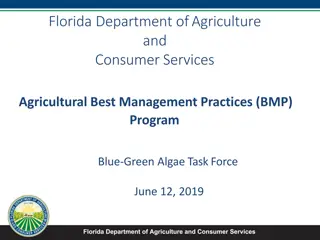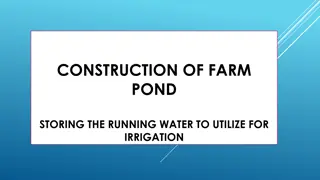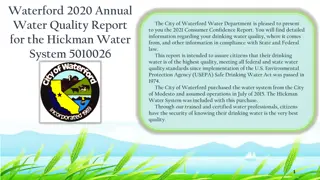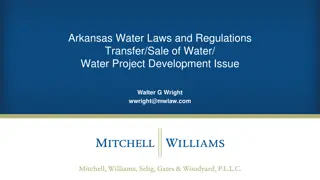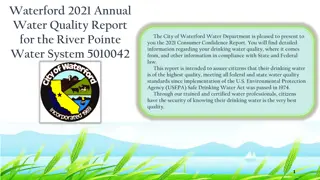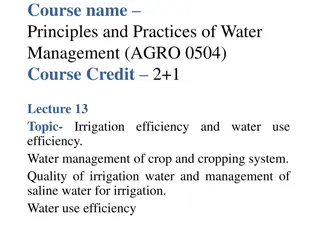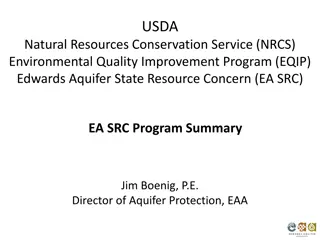Advancing Agricultural Water Quality Standards: Industry Perspectives
Industry perspectives on risk-based criteria for agricultural water quality are shared by Jennifer McEntire, PhD, VP of Food Safety at United Fresh Produce Association. The discussion covers the importance of water quality in food safety, shifts in industry mindset towards risk management, regulatory requirements, microbial water quality standards, challenges faced, and the delay in compliance with agricultural water standards. The need to support science and risk-based regulation is emphasized.
- Agricultural Water Quality
- Risk-Based Approaches
- Food Safety
- Industry Perspectives
- Regulatory Compliance
Download Presentation

Please find below an Image/Link to download the presentation.
The content on the website is provided AS IS for your information and personal use only. It may not be sold, licensed, or shared on other websites without obtaining consent from the author. Download presentation by click this link. If you encounter any issues during the download, it is possible that the publisher has removed the file from their server.
E N D
Presentation Transcript
Advancing the science of risk-based criteria for agricultural water quality: Industry perspectives on the use of risk-based approaches Jennifer McEntire, PhD VP, Food Safety United Fresh Produce Association FVIAC Aug 14, 2019
Key Points Everyone knows ag water quality is important to food safety Regulatory requirements are on pause Industry mindset around managing risk has shifted Leafy greens producers Breadth of produce industry Next steps Continue to support science Support science & risk based regulation
Standards for the Growing, Harvesting, Packing, and Holding of Produce for Human Consumption, current Subpart E all agricultural water must be safe and of adequate sanitary quality for its intended use ( 112.41) water that is intended to, or is likely to, contact the harvestable portion of covered produce or food-contact surfaces ( 112.3(c)) Requirements on inspection/maintenance of ag water sources and systems, microbial quality, and record-keeping Microbial limits are specified Specifies generic E. coli as the indicator organism
PSR Requirements Microbial water quality profile (MWQP) rolling 4-year data set of water testing results geometric mean (GM) of 126 or less CFU generic E. coli/100 mL water statistical threshold value (STV) of 410 or less CFU generic E. coli/100 mL water Die off provision The requirement for agricultural water used during and after harvest is no detectable generic E. coli in 100 mL of water.
Challenges The math The logistics The method Is it the right standard? Recreational water Other hazards
Delay of Ag Water Compliance The extension is designed to provide additional time to ensure the FDA applies the best thinking to clarify standards for pre- harvest microbial water quality and to continue working closely with produce farmers on sensible approaches to protect consumers March 15, 2019 Statement from former-Commissioner Gottlieb https://www.fda.gov/NewsEvents/Newsroom/PressAnnouncements/ucm633586.htm FDA needs time to compile and interpret the science Opportunity for industry to provide input and support Rulemaking required if updates made to the standards
Industry Response(s) April 2019 update to LGMA guidelines Covers ~90% of leafy greens grown in US Emphasis on evaluating ag water risk based on: Source, storage, and conveyance Water use/application Timing of application
Categorizes water into types: A, B, and B A (treated) Defines acceptable uses of water categories **Open source water must be treated (verified method) if applying overhead within 21 days of harvest CA-LGMA currently working on guidance to help growers validate ag water treatment systems
Harmonized Ag Water Working Group Initiated in 2018 to mitigate varying interpretations on how to conduct a risk assessment Basic risk assessment decision tree based on: Crop use Water source Water delivery system Application method Detailed hazard mitigation table
Industry Needs More science; communicate what we already know CPS, PSA, etc. Continued collaboration with FDA United Fresh shared risk assessment guidance Developing position statement as FDA reevaluates Subpart E Be proactive don t wait for FDA









